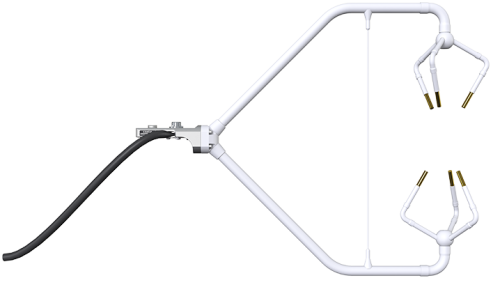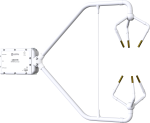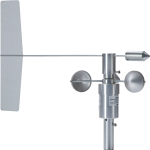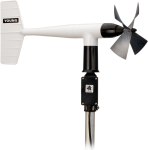
El mejor instrumento para proyectos investigación de flujos y turbulencias






Resumen
El anemómetro sónico CSAT3A equivale al cabezal del anemómetro sónico CSAT3, con el cable modificado para conectar al módulo electrónico EC100. El CSAT3A se utiliza en nuestros sistemas "eddy-covariance" junto al analizador "open-path" EC150 y el analizador "closed-path" CPEC200.
Leer másVentajas y características
- New conformal coating helps protect sonic transducers in corrosive environments
- Innovative design provides precision turbulence measurements with minimal flow distortion
- Usually combined with EC150 or EC155 gas analyzers giving near complete colocation for eddy-covariance measurements
- Compatible with most Campbell Scientific data loggers
- Measurements can be used to calculate momentum flux and friction velocity
- Campbell Scientific’s fine wire thermocouples are an option for fast-response temperature measurements
- Field rugged
- Innovative signal processing and transducer wicks considerably improve performance of the anemometer during rain events
- Sealed sonic transducers and electronics
Imágenes



Descripción detallada
The CSAT3A is an optional component of an EC150 open-path or EC155 closed-path CO2/H2O gas analyzer. It attaches to a common mounting bracket and connects to the gas analyzer's EC100 electronics module.
Productos similares
Preguntas frecuentes
Número de FAQs relacionadas con CSAT3A: 22
Expandir todoDesplegar todo
-
Ultrasonic anemometers are unable to make measurements if the sonic path is blocked. The path may become blocked by water that puddles on the lower transducer face or droplets that hang from the upper transducers. Sonic wicks, which come with all sonics, can be placed on the transducers to wick away moisture from the faces of the transducers. Ensure that these wicks are removed during cold conditions to prevent ice from building up around them.
-
No. The offset is a function of temperature and time. Once a year, spot-check the sonic anemometer wind offset using the procedure outlined in the CSAT3B instruction manual. If the measured offset is outside the specification, return the sensor to the factory for calibration. To request a return material authorization (RMA) number, follow the steps listed on our Repair and Calibration page.
-
The sensors used in the eddy-covariance application are not compatible with SCWin. An open-path eddy-covariance program is available for purchase as pn 18442, CRBasic Basic Eddy Covariance Program. This is the program without energy balance sensors. Also available is pn 18443, CRBasic Extended Eddy Covariance Program, with energy balance sensors. To order a custom configured program, contact the Environmental Group for assistance.
-
The CSAT3/3A/3H is compatible with three output signals: analog, RS-232, and Synchronous Device for Measurement (SDM). The sonic anemometer can be interfaced to any data-acquisition system that is compatible with analog measurements or RS-232 serial communications. SDM is used with Campbell Scientific data loggers.
-
The sonic anemometer measures three-dimensional wind in a right-handed Cartesian coordinate system. From these measurements, use trigonometry to compute the wind flow angle, horizontal angle, and wind speed.
-
The CSAT3/3A/3AH calibration applies a correction for transducer delay over temperature. Transducer delays cause an offset in the wind speed measurement, and to a lesser extent, an offset in the speed of sound measurement.
The CSAT3/3A/3AH speed of sound easement is corrected for the effects of wind blowing normal to the sonic path.
-
The sonic anemometer offset specification is ±8 cm/s. Therefore, it cannot be used in an application where the expected wind speed is in the range of ±5 cm/s.
-
The CSAT3A, CSAT3AH, CSAT3B, and CSAT3BH are calibrated over temperature for the effects of transducer delays on the wind speed, and to a lesser extent, for the speed of sound measurements.
There is no NIST-traceable standard for ultrasonic anemometers.
-
The CSAT3A, CSAT3AH, CSAT3B, and CSAT3BH—like other sonic anemometers—measure wind speed along the sonic path using ultrasonic signals. If the salt spray blocks the sonic path, the sonic anemometer will not be able to make measurements. The same is true if a thick layer of salt is deposited on the transducer faces.
Compatibilidad
Especificaciones
| Measurement Path Length |
|
| Path Angle from Horizontal | 60° |
| Construction | Sealed sonic transducers and electronics |
| Anemometer Head Materials | Stainless-steel tubing |
| Electronics Box Materials | Welded aluminum |
| Operating Temperature Range | -30° to +50°C |
| Voltage Supply | 10 to 16 Vdc |
| Current |
|
| Digital SDM Output Signal | CSI 33.3 k baud serial interface for data logger/sensor communication. (Data type is 2-byte integer per output plus 2-byte diagnostic.) |
| Support Arm Diameter | 1.59 cm (0.63 in.) |
| Transducer Diameter | 0.64 cm (0.25 in.) |
| Transducer Mounting Arm Diameter | 0.84 cm (0.33 in.) |
| Anemometer Head Dimensions | 47.3 x 42.4 cm (18.6 x 16.7 in.) |
| Anemometer Head Weight | 1.7 kg (3.7 lb) |
Measurements |
|
| Outputs |
ux, uy, uz, c (ux, uy, uz are wind components referenced to the anemometer axes; c is speed of sound.) |
| Speed of Sound | Determined from three acoustic paths; corrected for crosswind effects. |
| Measurement Rate | Programmable from 1 to 60 Hz, instantaneous measurements. Two over-sampled modes are block averaged to either 20 Hz or 10 Hz. |
| Output Bandwidths | 5, 10, 12.5, or 20 Hz |
| Output Rate | 10, 20, 25, or 50 Hz |
| Measurement Resolution |
|
| Offset Error |
|
| Gain Error |
|
| Rain | Innovative ultrasonic signal processing and user-installable wicks considerably improve the performance of the anemometer under all rain events. |
Digital USB and RS-485 Output Signal |
|
| Baud Rate | 230400 bps (maximum) |
| Data Type | Comma-delimited ASCII |
SDM, USB, & RS-485 Digital Outputs Reporting Range |
|
| Full-Scale Wind | ±65.535 m/s autoranging between four ranges (Least significant bit is 0.25 to 2 mm/s.) |
| Speed of Sound | 300 to 366 m/s (-50° to +60°C) Least significant bit is 1 mm/s (0.002°C). |
Documentos
Folletos producto
Manuales
- EC150 CO2 and H2O Open-Path Gas Analyzer and EC100 Electronics with Optional CSAT3A 3D Sonic Anemometer - 900
- Open Path Eddy Covariance System with IRGASON or EC150/CSAT3A Quick Deploy Guide
- EC155 CO2 and H2O Closed-Path Gas Analyzer and EC100 Electronics with Optional CSAT3A 3D Sonic Anemometer - 905
- CPEC300/306/310 Closed-Path Eddy-Covariance Systems
Documentos técnicos
Casos de aplicación
Forest habitats contribute more than any other terrestrial biome to carbon cycles and processes. It......leer más
Scientists and land-use managers have long recognized the importance of forest lands for their role......leer más
With instrumentation and help from Campbell Scientific, personnel from the Department of Atmospheric Sciences at......leer más










